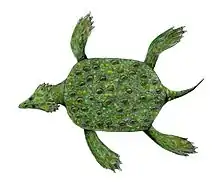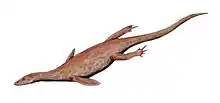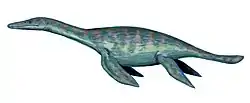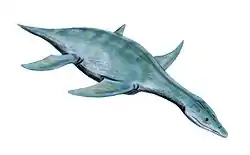Callawayasaurus
Callawayasaurus is a genus of plesiosaur from the family Elasmosauridae. When the first Callawayasaurus fossil was first discovered by Samuel Paul Welles in 1962, it was described as Alzadasaurus colombiensis before being moved into its current genus by Kenneth Carpenter in 1999.[1]
| Callawayasaurus | |
|---|---|
 | |
| Skull of Callawayasaurus colombiensis displayed in the Paleontological Museum of Villa de Leyva | |
| Scientific classification | |
| Kingdom: | Animalia |
| Phylum: | Chordata |
| Class: | Reptilia |
| Superorder: | †Sauropterygia |
| Order: | †Plesiosauria |
| Family: | †Elasmosauridae |
| Genus: | †Callawayasaurus Carpenter, 1999 |
| Species: | †C. colombiensis |
| Binomial name | |
| †Callawayasaurus colombiensis (Wells, 1962 [originally Alzadasaurus]) | |
| Synonyms | |
| |
Etymology
Callawayasaurus is named in honor of the paleontologist Jack M. Callaway, editor of Ancient Marine Reptiles who, as Carpenter put it, "in his brief career as a vertebrate paleontologist, did much to improve our understanding of marine reptiles."[1] The familiar suffix, -saurus comes from the Greek sauros (σαυρος), meaning "lizard" or "reptile."[2]
Description
The first skull of Callawayasaurus to be found was 35 centimetres (14 in; 1.15 ft) long,[3] while the animal as a whole grew up to 8 metres (26 ft) long. The nares of Callawayasaurus are elongated and positioned over the maxilla, which has 3-5 teeth.[2] The neck contains 56 vertebrae which are relatively short compared to other elasmosaurids.[2] Callawayasaurus fossils have no pectoral bars; in common with other plesiosaurs such as Terminonatator. They also lack postaxial accessory facets.[4]
Another nearly complete skeleton was found to be slightly more robust than the holotype specimen. This subtle change may indicate sexual dimorphism.[2]
Distribution
The first Callawayasaurus remains were found in the Paja Formation near Leiva, Boyaca Colombia.[2] The species name for the type, "columbiensis", means "from Colombia".[2] Callawayasaurus are known from the Aptian faunal stage of the early Cretaceous period, which extended from 125 to 112 million years ago.[5]
References
- Carpenter, K. 1999. "Revision of North American elasmosaurs from the Cretaceous of the Western Interior". Paludicola 2(2):148-173.
- "ppne.co.uk entry on Callawayasaurus". Archived from the original on 2011-07-28. Retrieved 2008-03-06.
- "oceansofkansas.com entry on Callawayasaurus". Retrieved 2008-03-08.
- Patrick S. Druckenmiller and Anthony P. Russell., "A new Elasmosaurid Plesiosaur (Reptilia: Sauropterygia) from the lower Cretaceous Clearwater Formation, Northeastern Alberta, Canada". Vertebrate Morphology Research Group, Department of Biological Sciences, University of Calgary
- "stratigraphy.org entry on Apitan stage". Archived from the original on 2008-02-09. Retrieved 2008-03-06.






.png.webp)


.jpg.webp)
